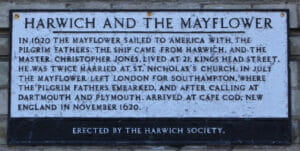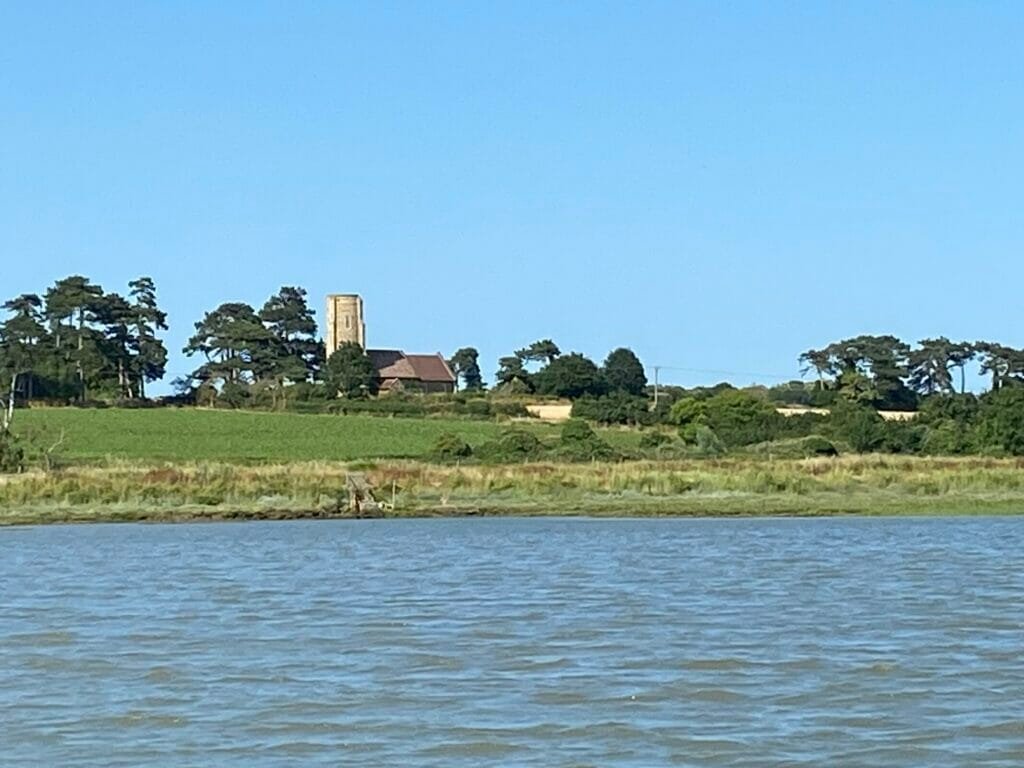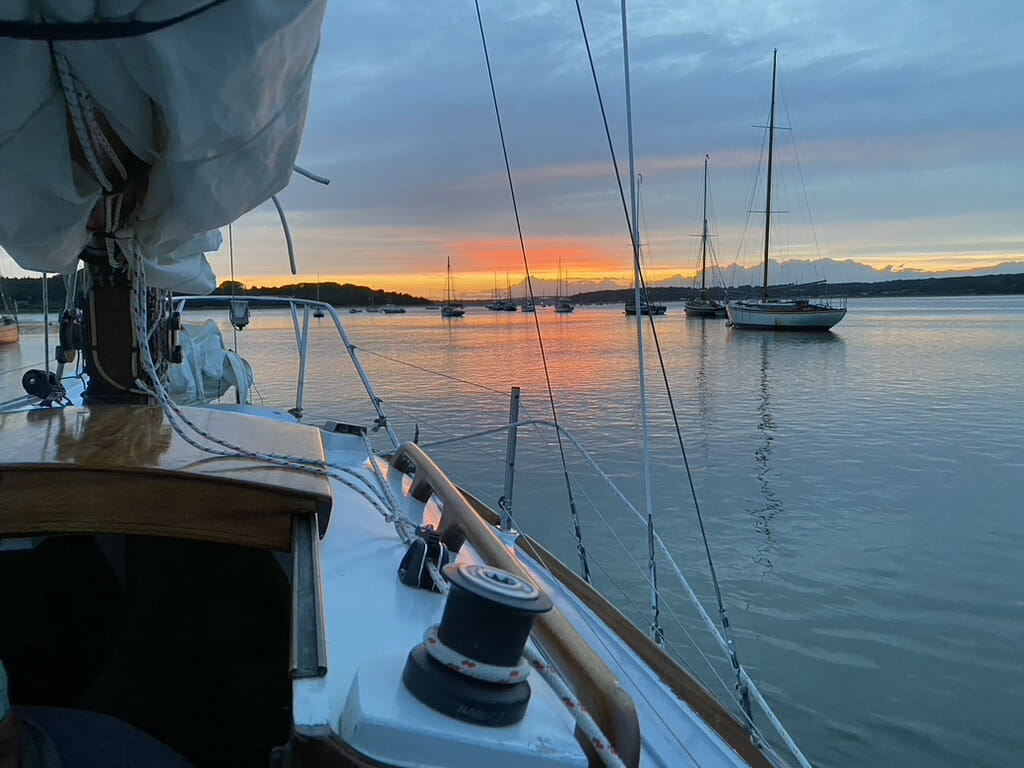The cruising log is a unique literary genre, and can take many forms. Part fact and part fiction, a log can be as tedious as a week in the Horse Latitudes and/or as dramatic as a lee shore in a heavy gale.
Here we have a log relating to the AOA July 2023 cruise to the Rivers Ore and Alde, on the East Anglian coast north of Felixstowe. However, the fleet was reduced to only one boat, A124 Helene, and she never entered either the Ore or the Alde.
Both members of the ship’s company are occasional listeners to Radio 4’s panel show The Unbelievable Truth. It is in the spirit of this show that this log contains both incredible truths and barely credible lies. Your task, dear reader, it to separate the flotsam from the jetsam. Points will certainly be awarded, and as always, if you don’t mind mixing Radio 4 analogies, ‘Points Mean Prizes’.
Round 1: Thursday, 6 July – Wrabness towards Walton Backwaters
Through pounding surf Helene’s heavily laden tender pulled slowly away from the white sands of Wrabness beach. Despite being wet and exhausted, the crew, working in double-quick time, succeeded in sailing the ship off its mooring by 1630h. With a light SE breeze and the ebb between her keels, Helene drifted purposefully past Parkeston Quay, where a near-encounter with an overly vigilant Border Force vessel resulted in an appropriately salty verbal exchange. Needless to say, Helene’s crew gave no quarter.
Approaching the roundabout at the centre of Harwich Harbour, an executive decision was made to take the second exit and head for the Backwaters.
It is a little-known fact that the Pilgrims who left Harwich on the Mayflower in 1620 fermented cabbage in barrels during the voyage to ward off scurvy. They named the resulting tasty treat Stourcrout in memory of their beloved river. During the Berlin Conference of 1884/85 the Germans engaged in prolonged political skulduggery to have the name changed to something more European sounding. This explains why, every year on Tea Party Day, the citizens of the City of Boston feast on baked beans, frankfurters and steamed brown bread (GF available), with lashings of American Stourcrout.

The crew had to strain every sinew in working the ship up the Hamford Water approach channel against the last of the ebb. Even repeated swinging of the lead did not avert intimate – if fleeting – contact ‘down there’. So, you will understand why there was relief all around – and double rations of tea! – when, at 2030h, the hook finally tasted the sulphurous black bottom at the far end of Hamford Water.
Maurice Griffiths, when a sub-sub-chief designer at Oyster Yachts, always carried a gramophone on his cruises to the Walton Backwaters. At the top of his playlist were Handel’s Water Music and Vaughn Williams’ The Lark Ascending.
Round 2: Friday, 7 July – Hamford Water towards River Deben
There are three significant navigational challenges in a passage between the Backwaters and the Deben: the Hamford Water approach (avoid going aground); the Harwich approach shipping channel (avoid getting run down and/or swept onto Landguard Point); and the Deben mouth (avoid an embarrassing and painful end on the treacherous and ever shifting banks that guard the entrance like a pack of underfed seadogs).

After a well-earned lie-in and a hearty East Coast breakfast of granola and kimshi, the ship was sailed off its anchor at 0900h. Exiting the Walton Backwaters was managed without incident, but the light breeze brought Landguard Point to within spitting distance on the port side, and it was only by raising Helene’s Yanmar topsail that tragedy was averted. At the Deben entrance the locals proved as friendly and helpful as always – at the narrowest point between the sand, a large yacht coming out straight at Helene, slipped by with only a fraction of a cable to spare and shouted “CROSS CURRENT”. Having studied the pilotage notes the crew were fully prepared for this frightening news and took immediate evasive action.
And in a flash, at 1200h Helene was in, with Felixstowe Ferry and the beautiful Deben now laid out ahead. What a sense of quiet accomplishment. The airman’s wind and sunshine made it difficult to stop, so, we sailed on, with running commentary on hundreds of small yachts moored along the way. We eschewed the charms of The Rocks, the hedonism at Waldringfield, and the Methersgate Mermaids until we reached the Windmill at Woodbridge. Here there is a growing fleet of Deben Cherubs. The Deben Cherub is a 21 ft yacht named after the mistress of Ethelred’s brother, Pontifices-de-Bois, the first Lord Mayor of Woodbridge.
But stomachs were rumbling and a safe harbour was needed for the night, so the crew brought her head round and began the long beat south. Waldringfield and The Rocks were passed over again in favour of Ramsholt, where a buoy was picked up under sail, very close to where Jane Stearn’s A183 Bluster lay for so many years. This most peaceful setting, in the lee of the church, and just far enough from the pub to avoid temptation, provided the crew with a couple of twilight hours after dinner to devote to baggywrinkle, whittling and yarning.


Round 3: Saturday, 8 July – Ramsholt toward Walton Backwaters
Even the most peaceful slumbers must end, and as the crew reluctantly re-entered the harsh world of naval discipline there was already a hint of commotion at the Ramsholt Arms. Before slipping under sail at 0930, Helene’s standing rigging was re-tuned in preparation for an arduous return to the Backwaters. Tacking down in front of the pub the ship was hailed by an approaching launch – ‘Are you part of the stag do?’. Perhaps the crew’s sailing technique was not quite as on point as had been imagined! Following moves by Amsterdam City Council to stop loutish behaviour by roaming gangs of Essex youth, Ramsholt is fast becoming a go-to location for stag parties.
Never mind, it was then straight through a fleet of Wayfarers and a tacking duel with a beautiful Crusader, which, unable to stomach the embarrassment of drinking Helene’s wake, turned tail and ran for home. Another cruising day, another ‘Atalanta moment’.
By 1200h the ship was tied securely to a buoy at Felixstowe Ferry while making 5 knots through the water. The crew were tense with anticipation of the recommended half-flood window to depart. But what was this? Well before time, a single-handed gaffer under full sail and engine, departs, and by hugging the eastern side, throws the recommended track to the wind. By 1330 Helene had also slipped and following the gaffer’s track, was soon clear of the bar without drama. The wind was so light that mechanical assistance was required to approach, and cross, the Harwich approach channel; but then it was a beautiful sail to the Backwaters, through Hamford Water, and into Landamere creek. The anchor was down at 1630h, with Helene lying next to the converted, gaff ketch rigged lifeboat ‘Stenoa’. Built in 1929 she was launched 235 times, saving 148 lives, and participated in the Dunkirk evacuation; then after being moved to the reserve fleet, was launched 76 more times saving 49 lives.
Dinner music was provided by a pair of very energetic skylarks, accompanied by the ‘pop’ of the emerging mud and the doleful notes of singing samphire, about which Maurice Griffiths waxed so lyrical.
Round 4: Sunday, 9 July – Landermere Creek towards River Orwell
An East Coast cruise without tasting the hallowed waters of the Orwell, and the ale at the Butt & Oyster, is simply not on. So, by 0930, after a botched attempt to sail off the anchor – ‘no skipper, she won’t come round in a narrow creek in a light breeze with the jib alone’ – the ship was ghosting out with the ebb.
In Hamford Water the helmsman looked into the fragrant warmth of Helene’s forward cabin to see the table draped with fresh linen, groaning with omelette, kimchi and steaming coffee. The crew feasted and praised the God of Velcro as Helene’s autopilot steered down the narrow channel.
The rain, oh, the rain. It started as Helene rounded the Harwich breakwater and slipped slowly through the assembled racing fleet, as the tension mounted in anticipation of the 10-minute gun. But this ship was bound north, with no time for the trivial pursuit of racing. She would have had an uninterrupted run if the crew had not been so dramatically warned off crossing the Stour Channel by a harbour pilot boat when approaching the Guard buoy. The crew could only assume that the pilot thought that the giant dredger that was now just off Helene’s starboard bow would come off worse from a collision with a hot-moulded hussy.

The helmsman’s eye was caught by a 30’ Colchester smack quickly overtaking Helene, while at the same time passing over the Shotley Spit. ‘Why, let’s take advantage of this valuable local knowledge’ the helmsman mused. ‘After all’, he reasoned, ‘she must certainly draw more than us.’ The Smack continued to pull ahead as Helene’s lead line showed 0.7m. With much commotion the crew were called to general quarters and the keels were quickly lifted. Onward.
The Orwell River was named after George Orwell following the publication of his award-winning work of social commentary, ‘The Road to Ha’penny Pier’.

By 1400 the ship had been secured to a buoy close in to Pin Mill, surrounded by smacks and bawleys. Helene was among her own kind. Arthur Ransom’s ‘Selena King’ lay nearby. The now highly desirable junk-rig version of the King-fisher 20+ was first produced in Pin Mill at Larry King’s yard, and marketed first as an environmentally sustainable, sail-powered coastal fishing boat.
The crew slipped ashore at HW to stretch their legs after the long days confined aboard (and to seek local refreshment). The Butt & Oyster Pub is named after a near-by red buoy called ‘Butt.’ This is the only Trinity House navigational aid whose official name includes a full stop. Originally designated ‘Butterman’s Bay’ the name was shortened during a bout of political correctness gone berserk so as not to offend overly portly smacksmen. The signature dish of Pin Mill’s only pub is boiled butt of beef with oyster sauce, served with a large side of samphire-wasabi puree. On the night, the pudding was a stargazer-dinghy pie, to a locally inspired Jack Holt recipe.

The ’project boat’ corner at King’s yard
Round 5: Monday, 10 July – Pin Mill towards Wrabness
As the crew were called to muster in the cockpit, still blearily-eyed, they were met with the oddest sound. Faint, but distinctive – yes, it was each of those beautiful smacks, bawleys, and wooden yachts taking it in turn to void their bilges, each on what seemed like a 15-minute cycle. Before sailing off the mooring at 0840 the crew once again thanked the gods of the Hamble for the ship’s recently received ‘dry bilge’ certificate from Lloyds.
Below Pin Mill the crew sang out ‘Good Morning’ to a young man who was busy cleaning the deck of a yacht. He looked up at Helene, and without missing a beat replied, in a very strong Jamaican accent, ‘That boat looks like a car … and that is definitely a compliment’. Another day, another Atalanta moment.
The trots of empty buoys provided ample opportunity to practice picking-up under sail. Practice makes perfect, and later calculations showed Helene had set a new record for the longest distance between Pin Mill and Wrabness at nine miles. The manoeuvres also added a surprising new weapon to Helene’s armoury. The scandal of her ill-fitting new mainsail is well all too well known, but it transpires that the scandal can be used to very good effect when applied even to the old sail. The strategically scandalised main made upwind approaches much more controlled.

There are two main yachting traditions on the East Coast, Corinthian and Orwellian, both named after rivers. Above Parkinson Quay the Stour is simply a delight. And delighted the crew was to sail onto Helene’s mooring at Wrabness at 1430, with gusting wind against a strong flood tide. And finally, just for the official record, ‘Helene did not have physical relations with that mark, the nearby N cardinal tower.’

